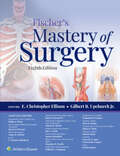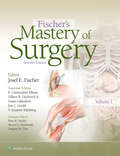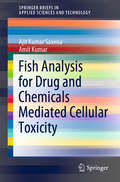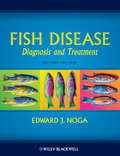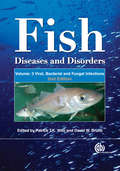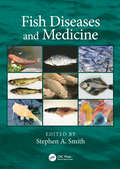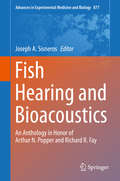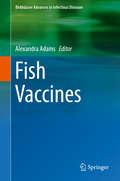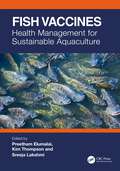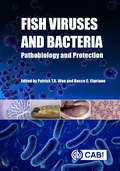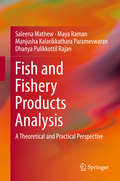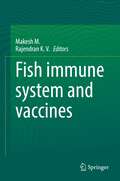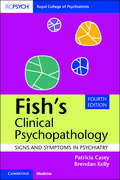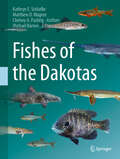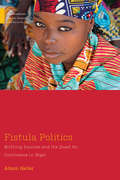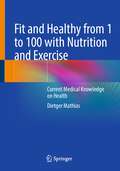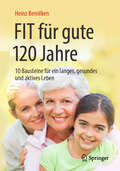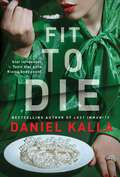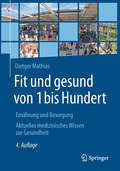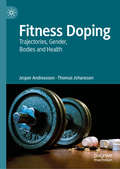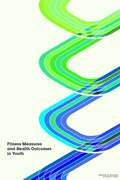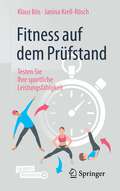- Table View
- List View
Fischer's Mastery of Surgery
by Gilbert R. Upchurch Jr. E. Christopher EllisonFor 40 years, Fischer’s Mastery of Surgery has provided expert, highly illustrated coverage of the procedures that general surgeons and trainees need to know. The fully revised eighth edition, under the editorial leadership of Drs. E. Christopher Ellison, Gilbert R. Upchurch Jr., Philip A. Efron, Steven D. Wexner, Nancy D. Perrier, V. Suzanne Klimberg, John H. Stewart IV, Valerie W. Rusch, Jon C. Gould, Susan Galandiuk, Timothy M. Pawlik, William C. Chapman, Benjamin K. Poulose, Peter K. Henke, Alicia M. Mohr, Saleem Islam, Anne M.R. Agur, Carol Scott-Conner, and David Renton continues the tradition of excellence with two full-color volumes that include the essentials of diagnosis, anatomy, and pre-operative planning while maintaining a focus on clear, step-by-step depictions and descriptions of procedures.
Fischer's Mastery of Surgery
by Josef FischerHere are the core procedures every general surgeon needs to master, in step-by-step detail with commentary from experts in the field. In two full-color volumes, Fischer’s Mastery of Surgery, Seventh Edition includes the essentials of diagnosis, anatomy, and pre-operative planning while maintaining a focus on clear, step-by-step depictions and descriptions of procedures. This thoroughly revised edition brings you up to date with evidence-based approaches for virtually any surgery you’ll be called upon to perform.
Fish Analysis for Drug and Chemicals Mediated Cellular Toxicity (SpringerBriefs in Applied Sciences and Technology)
by Amit Kumar Ajit Kumar SaxenaThis book offers a comprehensive overview of drug and chemical cellular toxicity, especially concerning the effects of anticancer drugs (cyclophosphamide, methotrexate and phosphamidon) on chromosomes and proteins. It covers histological changes in rat testis during pre- and postnatal exposure to varied drug doses, along with laboratory findings on arsenic exposure and alcohol consumption producing neurological changes and deleterious effects on reproductive health in animals. The book offers essential information on the role of anticancer drug- / chemical-mediated toxicity in connection with genetic changes in the brain and reproductive health, making it a valuable guide for researchers working in the areas of cancer research, infertility, molecular diagnostics and modern drug discovery, at biochemical and toxicity laboratories, and in genetic predisposition and molecular biology in general.
Fish Disease: Diagnosis and Treatment
by Edward J. NogaFish Disease: Diagnosis and Treatment, Second Edition provides thorough, yet concise descriptions of viral, bacterial, fungal, parasitic and noninfectious diseases in an exhaustive number of fish species. Now in full color with over 500 images, the book is designed as a comprehensive guide to the identification and treatment of both common and rare problems encountered during the clinical work-up. Diseases are discussed following a systems-based approach to ensure a user-friendly and practical manual for identifying problems. Fish Disease: Diagnosis and Treatment, Second Edition is the must-have reference for any aquaculturists, aquatic biologists, or fish health specialists dealing with diagnosing or treating fish diseases.
Fish Diseases and Disorders, Volume 3: Viral, Bacterial and Fungal Infections (2nd edition)
by Patrick T. K. Woo David W. BrunoThis third and final volume in the acclaimed Fish Diseases and Disorders trilogy addresses infectious diseases of finfish and shellfish caused by viruses, bacteria and fungi. Topics covered include infectious pancreatic necrosis virus, infectious hematopoiectic necrosis virus, viral diseases of cold- and warm-water fish, rickettsial and chlamydial infections, furunculosis, motile aeromonads, vibriosis, flavobacterial diseases and shellfish diseases. Written by experts in each discipline and updated throughout to reflect new developments in the field, including new chapters on alphaviruses, oncogenic viruses and genomics and proteomics, this is a must-have reference for fish health specialists and veterinarians, microbiologists, zoologists and researchers, and students in aquaculture.
Fish Diseases and Medicine
by Stephen SmithFish are critically important to the welfare of this planet and its occupants, the health of both wild and captive fish populations paramount to our survival. This book presents the gross pathology of the most commonly encountered diseases and syndromes of fish in an organ system-based approach. It provides an overview of the di
Fish Hearing and Bioacoustics
by Joseph A. SisnerosFish Hearing and Bioacoustics is an anthology of review papers that were presented at a special symposium to honor Arthur Popper and Richard Fay on May 25th 2013 at the Mote Marine Laboratory in Sarasota, FL. The research presentations at this conference spanned the range of disciplines covered by Fay and Popper during their long and productive careers. The book includes the following thematic areas for the papers in this special volume: morphology and anatomy of the inner ear and lateral line systems; physiology of inner ear, lateral line, and central auditory systems; acoustically mediated behavior, including communication and sound localization; and environmental influences on fish hearing and bioacoustics, including anthropogenic effects of noise on fishes. Each chapter reviews and summarizes the past studies of particular area that will lead the reader up to the current work presented at the symposium. In addition, each chapters includes a perspective of how Arthur Popper and Richard Fay have influenced their particular area of fish bio acoustic research. Each manuscript also includes a hypotheses for future studies. These hypotheses will provide a springboard for future work in each field.
Fish Oil: How this natural healer can help arthritis, skin disorders and encourage better health (Wellbeing Quick Guides)
by Liz EarleLiz Earle looks at the latest research into Britain's most popular health supplement and explains how it can be used to relieve a variety of ailments, including arthritis, psoriasis and eczema.Bestselling beauty and wellbeing writer Liz Earle's fully revised and updated quick guide to cod liver oil, including:- The history of the oil and its legendary properties- How essential fatty acids work- The latest research into the oil for arthritis - How it helps the skin (including eczema and psoriasis problems)- A dosage guide for the family
Fish Vaccines
by Alexandra AdamsThis book provides a useful text for research students and scientists on the latest knowledge about the immune system of fish, cutting edge technologies and the step required to develop, test and commercialise fish vaccines. It brings together information that is currently difficult to obtain in one book, and highlights problem areas and research topics that still need to be addressed to improve future vaccines.
Fish Vaccines: Health Management for Sustainable Aquaculture
by Kim Thompson Preetham Elumalai Sreeja LakshmiThis book is a timely reference text that highlights the role of vaccination in the fast-growing aquaculture industry. It discusses topics such as vaccine formulation, vaccine delivery, and enhancing the immune response of fish using nanoparticles. Information related to vaccine safety, ethical approval, and regulations is also discussed, together with dissemination of vaccines to fish farms across the globe. This cutting-edge book presents novel strategies to meet the growing demand for vaccines in finfish aquaculture. This book is useful to students, academics, clinicians, and professionals in the field of fisheries sciences, aquaculture, and veterinary sciences.
Fish Viruses and Bacteria
by Patrick T.K. Woo Rocco C. CiprianoTaking a disease-based approach, Fish Viruses and Bacteria: Pathobiology and Protection focuses on the pathobiology of and protective strategies against the most common, major microbial pathogens of economically important marine and freshwater fish. The book covers well-studied, notifiable piscine viruses and bacteria, including new and emerging diseases which can become huge threats to local fish populations in new geographical regions if transported there via infected fish or eggs. A concise but thorough reference work, this book: - Covers key viral and bacterial diseases of notable fish species; - Reviews major well-established piscine pathogens as well as new, emerging and notifiable diseases; and - Contains the most up-to-date research contributed by a team of over fifty world experts. An invaluable bench book for fish health consultants, veterinarians and all those wanting instant access to information, this book is also a useful textbook for students specializing in fish health and research scientists initiating fish disease research programmes.
Fish and Fishery Products Analysis: A Theoretical and Practical Perspective
by Maya Raman Saleena Mathew Manjusha Kalarikkathara Parameswaran Dhanya Pulikkottil RajanThis novel and informative book discusses the various aspects of seafood quality. The book is divided into 7 broad sections, each tackling a different aspect. The first section covers the general aspects relevant to the nutritional quality of the fish and the various extraction protocols for macro-/ micro-nutrients. The second section provides insights into handling and the principles of thermal and non-thermal processing techniques for commercially important fishery products. The quality standards and safety concerns in the seafood industry and consumption are discussed in this section. The freshness indices of the processed products including biochemical, microbiological and toxicological characteristics are also included. The third section discusses the physico-chemical characteristics and quality parameters of potable water/ ice. The fourth section includes the quality assessment of various toxicants related to seafood products. The fifth section deals with the specific aspects such as principle, instrument and procedures of conventional and novel analytical instruments relevant to the seafood industry. The sixth section deals with the seafood waste management including solid and liquid seafood wastes. Presently, there is a great awareness regarding environmental sustainable processing/ preservation techniques. The final chapter discusses the bioactive compounds from under-utilized marine sources showing pharmaceutical/ nutraceutical applications.
Fish immune system and vaccines
by M. Makesh K. V. RajendranThis book is a collection of comprehensive and latest information on all aspects of vaccination in fish and shellfish. It provides the basic understanding about the immune system of both fish and crustaceans, besides giving the latest information on adjuvants, vaccine delivery methods, adverse effects of vaccines and methods to assess the efficacy of vaccines. Separate chapters on the role of pattern recognition receptors and interferons in fish vaccination, biofilm vaccines and biosafety and regulatory requirements for fish vaccines are also included. Aquaculture, being the fastest growing food producing industry in the world, is looked upon for alleviating the malnutrition especially among the under privileged population. However, intensive aquaculture practices have led to increased incidences of diseases and significant production losses. Among various health management measures employed in aquaculture, vaccination has been proven to be the best approach to protect fish against pathogens. It is considered to be safe and is a key factor for sustainable aquaculture. In this background, apart from the basic understanding of fish and shellfish immune system, updated knowledge on various types of vaccines and the vaccination strategies currently employed in aquaculture are also covered. The book is designed to provide the latest and comprehensive knowledge on all these aspects as a compiled resource material which is useful to students, researchers and other professionals in the field of aquaculture.
Fish's Clinical Psychopathology: Signs and Symptoms in Psychiatry
by Brendan Kelly Patricia CaseyPsychopathology lies at the centre of effective psychiatric practice and mental health care, and Fish's Clinical Psychopathology has shaped the training and clinical practice of psychiatrists for over fifty years. The fourth edition of this modern classic presents the clinical descriptions and psychopathological insights of Fish's to a new generation of students and practitioners. It includes recent revisions of diagnostic classification systems, as well as new chapters that consider the controversies of classifying psychiatric disorder and the fundamental role and uses of psychopathology. Clear and readable, it provides concise descriptions of the signs and symptoms of mental illness and astute accounts of the varied manifestations of disordered psychological function, and is designed for use in clinical practice. An essential text for students of medicine, trainees in psychiatry and practising psychiatrists, it will also be useful to psychiatric nurses, mental health social workers and clinical psychologists.
Fishes of the Dakotas
by Kathryn E. Schlafke Matthew D. Wagner Chelsey A. PasbrigThis book describes all of the fishes found in North and South Dakota, USA. It contains a description of the waters and geology of the two states, information on the major rivers and water basins, detailed distribution tables, and a dichotomous key (already tested and in university use). A brief description of each fish family is included, and for each individual fish species found in North and South Dakota, high resolution color images, range maps, descriptions, and life histories are included. All of the information is referenced. The book also shows all of the fish sampling sites, briefly describes the history of fish sampling and identification in the Dakotas, and mentions the prominent individuals. This is the first book of its kind - the first comprehensive compilation describing every fish found in the Dakotas with all of the supplemental information.
Fistula Politics: Birthing Injuries and the Quest for Continence in Niger (Medical Anthropology)
by Alison HellerObstetric fistula is a birthing injury caused by prolonged obstructed labor that results in urinary and fecal incontinence. It is nearly non-existent in the Global North. In contrast Niger, in West Africa, has one of the highest rates of fistula in the world. In Western humanitarian and media narratives, fistula is presented as deeply stigmatizing, resulting in divorce, abandonment by kin, exile from communities, depression and suicide. In Fistula Politics, Alison Heller illustrates the inaccuracy of these popular narratives and shows how they serve the interests not of the women so affected, but of humanitarian organizations, the media, and local clinics.
Fit and Healthy from 1 to 100 with Nutrition and Exercise: Current Medical Knowledge on Health
by Dietger MathiasNutrition and exercise are the cornerstones of our health. But why actually? What exactly do weight training and endurance sports do? And how do certain foods influence our metabolism? How does sore muscles actually develop?The author, a chemist and doctor, explains in an understandable way how the body works and the influence of nutrition and exercise on our health. At the same time, he scientifically presents the correlations based on current studies, including intervention and long-term studies. He clearly describes the interactions of nutrition and exercise on body weight, metabolism, fatty tissue and hormones, the cardiovascular system, bone structure and the immune system. Each topic is clearly described on one page. A non-fiction book for all those who are interested in doing something for their health and want to know why.The 5th edition has been completely updated, adapted to the current state of knowledge and expanded to include the following topics: herbs and spices, endurance sports and hormone disorders in women, sports and painkillers, sustainable nutrition and plenty of exercise to combat climate change. Plus: glossary for looking up medical terms and extensive literature references on studies on nutrition, exercise and health.
Fit for Life, Not Fat for Life
by Harvey DiamondThere is only one concept to grasp and only one action to take: Eat more living food than dead food.
Fit für gute 120 Jahre: 10 Bausteine für ein langes, gesundes und aktives Leben
by Heinz BenölkenNach der WHO Gesundheitsformel ist ein Mensch gesund, wenn sich sein körperliches, seelisches und soziales Wohlbefinden im Gleichklang befinden. Dieser Ratgeber vermittelt in anschaulicher Form, wie sich gemäß dieser Formel das persönliche Wohlbefinden und damit die eigene Gesundheit anhand von 10 Bausteinen einschätzen lässt. Darüber hinaus zeigt das Werk, wie es in jedem Alter, mit einfachen Maßnahmen und Vernetzung der Bausteine gelingt, lange geistig und körperlich fit und biologisch jung zu bleiben. Das Buch wendet sich an alle, die ihre Gesundheit in die eigenen Hände nehmen, möglichst früh der Entstehung von Zivilisationskrankheiten entgegenwirken und einen präventologischen Lebensstil für sich umsetzen wollen.
Fit to Die: A Thriller
by Daniel KallaFrom internationally bestselling author Daniel Kalla comes a riveting thriller about online body shaming, toxic diet pills, a vulnerable mega-celebrity, and a rapidly rising body count.When Owen Galloway, the track star son of a prominent US senator, is found dead of an overdose in his bedroom, LAPD Detective Cari Garcia suspects that he&’s just another teenager who hid a drug addiction. In Vancouver, Dr. Julie Rees, an experienced toxicologist, notices a growing number of overdoses among the eating disordered and body builders, and mentions it to her boyfriend, Detective Anson Chen. Then Rain Flynn, a famous pop star and social media influencer, dies in her Vancouver hotel room showing the same symptoms of a fatally high fever and uncontrollable seizures as Julie&’s other ER patients, including the coowner of a wildly popular wellness center with locations in both Vancouver and LA. After an autopsy confirms that Rain overdosed on illicit diet pills containing a deadly toxin known as DNP—an explosive agent originally used in the trenches of World War I—the media gets hold of the story and runs wild with it. But who&’s behind the online marketing and distribution of DNP? And how is the wellness center connected? The daunting challenge of putting the pieces together falls to Detectives Garcia in LA and Chen in Vancouver. Can they solve these crimes before DNP becomes the next viral TikTok challenge?
Fit und gesund von 1 bis Hundert mit Ernährung und Bewegung: Aktuelles medizinisches Wissen zur Gesundheit
by Dietger MathiasErnährung und Bewegung bilden die Grundpfeiler für unsere Gesundheit. Doch warum eigentlich? Was bewirken Kraftsport und Ausdauersport genau? Und wie beeinflussen bestimmte Nahrungsmittel unseren Stoffwechsel? Wie entsteht eigentlich Muskelkater?Der Autor als Chemiker und Arzt erklärt verständlich zum einen die Funktionsweise des Körpers und den Einfluss von Ernährung und Bewegung auf unsere Gesundheit. Gleichzeitig stellt er die Zusammenhänge anhand von aktuellen Studien, u.a. Interventions- und Langzeitstudien, wissenschaftlich dar. Verständlich beschreibt er die Wechselwirkungen von Ernährung und Bewegung auf das Körpergewicht, den Stoffwechsel, auf Fettgewebe und Hormone, das Herz-Kreislauf-System sowie den Knochenbau und das Immunsystem. Jedes Thema wird übersichtlich auf jeweils einer Seite beschrieben. Ein Sachbuch für alle Interessierten, die gezielt etwas für Ihre Gesundheit machen möchten und wissen wollen, warum.Die 5. Auflage wurde vollständig aktualisiert, an den aktuellen Wissensstand angepasst und um folgende Themen erweitert: Kräuter und Gewürze, Ausdauersport und Hormonstörungen bei Frauen, Sport und Schmerzmittel, nachachhaltige Ernährung und viel Bewegung gegen den Klimawandel. Plus: Glossar zum Nachschlagen von medizinischen Fachgegriffen und ausführliche Literaturangaben rund um Studien zu Ernährung, Bewegung und Gesundheit
Fit und gesund von 1 bis Hundert: Ernährung Und Bewegung - Aktuelles Medizinisches Wissen Zur Gesundheit
by Dietger MathiasDie zurzeit weltweit größten Interventions- und Beobachtungsstudien vermitteln einen exzellenten Überblick über unser aktuelles Wissen zu den physiologischen Wechselwirkungen von Ernährung und Bewegung u. a. hinsichtlich Körpergewicht, Stoffwechsel, Fettgewebe, Hormone, Herz-Kreislauf-System sowie des Knochenbaus und der Immunität. Die Ergebnisse dieser Langzeitstudien sind Grundlage für die Ausführungen im vorliegenden Buch. Jedes Thema wird dabei sehr übersichtlich auf jeweils nur einer Seite behandelt. Wichtige physiologische Anpassungsmechanismen werden aufgezeigt und die Grundprinzipien der Gesundheitsvorsorge diskutiert. Ein Sachbuch, das für alle Interessierten an dieser populären Thematik gut verständlich geschrieben ist. Für die 4. Auflage wurde der Text erneut überarbeitet und dem derzeitigen Wissensstand angepasst. Zusätzlich 7 Kapitel zu hochaktuellen Themen wie vegane Ernährung, Nahrungsmittelunverträglichkeiten u.v.m. 4.aktualisierte u. erweiterte Auflage
Fitness Doping: Trajectories, Gender, Bodies and Health
by Thomas Johansson Jesper AndreassonThis book compiles several years of multi-faceted qualitative research on fitness doping to provide a fresh insight into how the growing phenomenon intersects with issues of gender, body and health in contemporary society. Drawing on biographical interviews, as well as online and offline ethnography, Andreasson and Johansson analyse how, in the context of the global development of gym and fitness culture, particular doping trajectories are formulated, and users come into contact with doping. They also explore users’ internalisation of particular values, practices and communications and analyse how this influences understandings of the self, health, gender and the body, as well as tying this into wider beliefs regarding individual freedom and the law. This insight into doping goes beyond elite and organised sports, and will be of interest to students and scholars across the sociology of sport, leisure studies, and gender and body politics.
Fitness Measures and Health Outcomes in Youth
by Russell PatePhysical fitness affects our ability to function and be active. At poor levels, it is associated with such health outcomes as diabetes and cardiovascular disease. Physical fitness testing in American youth was established on a large scale in the 1950s with an early focus on performance-related fitness that gradually gave way to an emphasis on health-related fitness. Using appropriately selected measures to collected fitness data in youth will advance our understanding of how fitness among youth translates into better health. In Fitness Measures and Health Outcomes in Youth, the IOM assesses the relationship between youth fitness test items and health outcomes, recommends the best fitness test items, provides guidance for interpreting fitness scores, and provides an agenda for needed research. The report concludes that selected cardiorespiratory endurance, musculoskeletal fitness, and body composition measures should be in fitness surveys and in schools. Collecting fitness data nationally and in schools helps with setting and achieving fitness goals and priorities for public health at an individual and national level.
Fitness auf dem Prüfstand: Testen Sie Ihre sportliche Leistungsfähigkeit
by Klaus Bös Janina Krell-RöschWollten Sie schon immer wissen, wie es um Ihre körperliche Fitness bestellt ist? Brauchen Sie eine zielgerichtete Diagnose, um effektiv trainieren zu können? Dieses Sachbuch liefert Ihnen eine fachgerechte Anleitung zur Überprüfung der eigenen Fitness – sportwissenschaftlich fundiert und einfach in der Durchführung. Neben allgemeinen Grundlagen zum Messen und Testen werden zahlreiche Fitnesstests für Kinder, Jugendliche und Erwachsene vorgestellt. Sie erfahren, wie Sie Tests selbst oder mit anderen Personen durchführen, auswerten und die Ergebnisse interpretieren können. Dabei werden sämtliche Fitnessparameter wie z. B. Ausdauer, Kraft, Schnelligkeit, Beweglichkeit und Koordination adressiert. Durch eine anschauliche Bebilderung und mithilfe von abrufbaren Videoanleitungen ist das Sachbuch sehr leserfreundlich gestaltet und animiert zum Selber-Testen. Zudem wird Ihnen ein Fragebogen zur Selbsteinschätzung der eigenen Fitness an die Hand gegeben. Werden Sie Ihr eigener Cheftrainer und nutzen Sie die Testergebnisse, um Ihr Fitnessniveau zielgerichtet und individuell zu verbessern.
